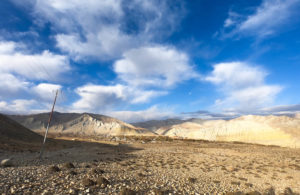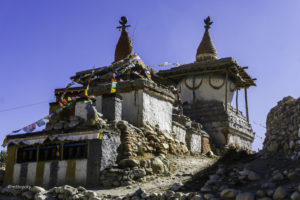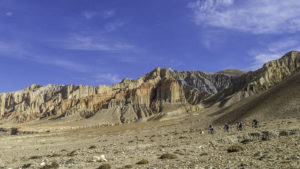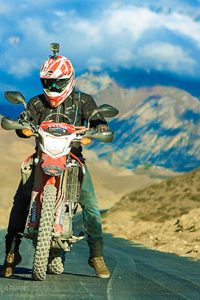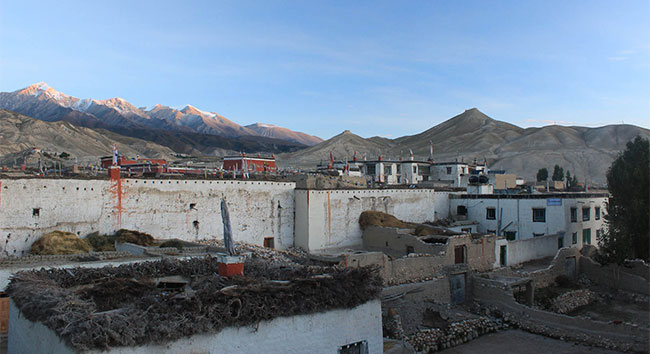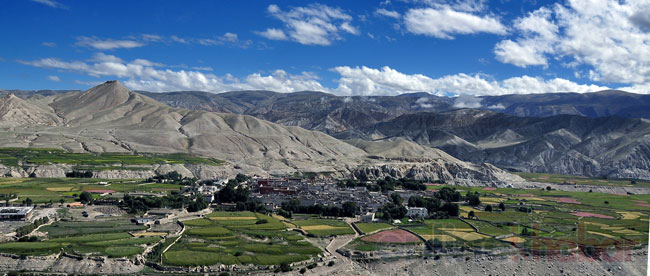At Tsarang, in the warmth of Maya’s Inn’s dining room, I never felt jauntier after those four grueling days on those wind-blasted dirt roads breathing in a ‘ton’ of dust and grit and almost succumbing to a disastrous experience at the Dajongla Pass on the second day. They were of a little matter now when I thought about Lo Manthang, just a trifling 16km away. I even broke into an animated chat with the guests and the hostess over a glass of my favorite Uwa (barley) liquor. My companions seemed no less excited at the prospect.
Maya Palbar Bista, who owned the inn, happened to be the late King of Lo Manthang, Jigme Dorje Palbar Bista’s Queen, Sidol Palbar Bista’s sister’s daughter. In her late thirtyish, she did not try to strike an attitude or show off that she came of a royal lineage. Not in the least.
Also read: Lo Manthang: Cycling to the lost kingdom on the other side of the Himalayas
Modest but down to earth, she seemed to have her hands full that entire evening preparing food and serving it juggling her work with her guests by satisfying their curiosity . . . with a smile. “We have been in business since more than a decade in this old house but we will be moving to our new building under way, hopefully, by next year,” she said. After supper, a big bowl of egg-veggie-noodle soup, and a refill of uwa liquor, we retired to our rooms and rode straight into our beds.

Day V
The first light of day at Tsarang heralded renewed enthusiasm and eager anticipation of seeing the Lost Kingdom. We hastily polished off a filling breakfast, dusted, oiled up our bikes and hopped on to our saddles to take a brief ride through the beautiful town. The weather was cold but sunny with no sign of wind.

As we wound our way through the maze of narrow cobbled lanes, I noticed that the entire town seemed fortified with white painted rammed earth walls separating the adobe houses. The fuel- wood (mostly twigs) neatly stacked on the roofs gave the impression of manicured hedgerow. Mane-wheels and chhortens seem to abound the streets and courtyards as we rode past. Sheep skulls with horns and Yak horns adorned the gate ways, doorways and the wall tops.

Built in the 13th century by the first King of Lo, Chhyogel Ame Pal Sangpo, it is said Tsarang or Charang got its name from the Tibetan word ‘Chaptrun Tsetran’ translating to a rooster’s wattle suggesting to the town built on a ridge over the Charang Chu canyon.

At one street corner we saw some large vessels sitting on wood-fired stoves. We asked the woman tending to the pots and learned that the vessels were used for distilling uwa liquor.

Shortly, we arrived at the imposing three-storey red Gompa, the Thupten Shedrub Dhargyeling Monastery saddling a narrow ridge defined against the blue sky. The ridge fell sharply to the Charangchu River forming a massive canyon. In winter, it is said glaciers can be sighted high above the canyon. The fierce-looking Tibetan mastiff we saw the other day was missing from the scene.
Also read: Lo Manthang: Exploring the Lost Kingdom on two wheels
Belonging to the Sa Skya (translating to pale earth) school of Tibetan Buddhism and built in 1427 under the patronage of King Samdrup Dorje the monastery bore a deserted look. With the cracked paint peeling off the walls, the building looked desperately in need of repair and restoration.
Luckily, we found a young monk hanging around with some kids at the back. A life-size gong stood besides the wall of the monastery. The young fellow led us into the gompa. Photography inside the gompa was prohibited.

We made around surprisingly large rooms with 15th century frescoes and priceless thangkas adorning the walls. One of the dim lit rooms had a large statue of Buddha and exotic Tibetan Buddhist artifacts, texts and murals. The monastery also housed an assembly room, but many rooms were left in disarray with cracked walls, and many needed rebuilding. Once, the monastery was said to have run a nunnery and housed hundreds of monks but less than fifty remain today. Sad and disappointed at seeing the gompa in a real bad shape, we left.
Also read: Lo Manthang: The challenging ride to the land of the Lowas
Next, the impressively large (5-storey) dzong(fort) palace perched on a sandstone cliff and ringed by a thick copse of poplar and wild willow right across the monastery, appeared yet more derelict, almost falling apart. Close to the building stood tall crumbling walls in ruins. We tried to find the resident lama of the dzong but not a soul seemed to be around.
As we were under a time constraint, we left but ran across a middle-aged monk dressed in a saffron-colored robe thumbing his prayer beads and heading towards the town. He was not the one who looked after the palace but was very helpful and helped us with bits of information on the fort.

“Samdrup Gephel Palace,” he began “was built in 1378 (before the monastery) by King Ame Pal, and once resided by the kings of Lo for centuries, and a pride of Tasarang. It still houses a prayer room with gold-lettered sacred book, large Buddha paintings, frescoes of prestigious Tibetan Gurus, and many ornate thangkas. ”
“Besides,” he continued, “the palace holds a mummified snow leopard, ancient weapons, chain mail armors, and a dried up 500-year old severed hand.” The story about the hand there differed from that of Gheling. The hand belonged to the master architect who built the palace. It was done so that he could not build another palace of that splendor.
He further added, “Sadly, the palace fell into disuse (over 50 years now) and neglect and has fallen into disrepair. It is even dangerous to try to go to the upper storey lest the ceilings or the walls might cave in.”
As we hit the dirt road heading north, I tried to imagine the palace in its heydays and piece together in my mind the loose ends, but eventually gave it up. As we rode past a large chorten (Sungda chorten), the wind seemed to turn ferocious bringing in its wake dust and sand.

The landscape looked desolate, treeless and the weather cold, and dry. As the road climbed I could see the utility poles flanking the dusty road in perfect symmetry but ludicrously out of place. Shayeet and Diwas led while I and Khasing fell behind by almost a kilometer. Just then I saw a flicker of movement high up on a sandstone cliff on my right. I stopped to look and there they were prancing about that sheer cliff, the blue sheep (Nayur or Bharal in Nepali). There were four of them.
Mesmerised, I watched those magnificent Himalayan ungulates as they perfectly blended into the cliff face with their fawn-colored hides. As Khasing hastily took out his camera from his backpack and took pictures, the sheep scampered off and were gone. Wow, that was fantastic! I cried out aloud.

We caught up with Shayeet and Diwas shortly. There were six other riders including Nishma (current women’s downhill champion, Nepal). The riders were from Czechoslovakia and had ridden all the way from Pokhara.
After the customary pleasantries (none of the Czech riders spoke English, though), I turned to the old lady dressed in a lama robe with a clutter of pots and pans and sundry scattered around. She’d a kettle on a small fire beside. I learned later that that was her quarters. She was a Lowa (Gurungs, Bistas and Biswokarmas) vagrant moving south to warmer climate as winter approached. She was alone and came from some village near the Tibetan border. How a 65 years old woman could fend for herself in those remote and unfrequented places, all by herself, I wondered. She offered us tea but did not accept to be paid.

After a brief stop, we bid the lady goodbye and set out; Nishma and the Czech group left earlier. The landscape got drier and isolated as we started on a gentle climb, the vast swathes of land around appearing like sand dunes of the rain-shadow desert of the Death Valley (watch video) and the Mojave in California, the United States.
After two hours on the dirt road, we began the climb to the Lo La Pass (3,950m) with a comforting feeling that it was our last. The wind seemed to lash at us with renewed intensity buffeting our bikes threateningly. The chill seemed to cut through the layers of our thermal wear and windcheaters to our bones. The fine dust and sand, on the other hand, made it difficult to see and hurt the eyes. Covered in dust, with puffy eyes and a bloated face caused by the cold, we all must have looked like apparitions from a ghost movie.
Dust, sand, or wind, we pushed on, stubborn and bullish, our heads low, heart’s pumping for more oxygen. “Ravi uncle, we’re nearing Lo La’” yelled Khasing over the awful din of the gale. That sent my pulse racing like mad because Lo Manthang (3,570m) rested literally a stone’s throw away from the pass.
Good grief, with my breath coming in gasps, and the heart-rate doubled, I feared for a moment that I might get a cardiac arrest! No such thing happened, though. Moments later we crested the top. And there nestled against a vast expanse of bare rolling hills lay Lo Manthang, the erstwhile Kingdom of Lo . . . and my long-cherished dream in all its glory. Sheer bliss!

Mesmerized, I looked, my eyes glued to the unfolding vista. In those brief moments, nothing else mattered or existed for me. Suddenly, I wanted to relate my feelings in poetry but words failed me. Whatever, I realized then that dreams do come true . . . if you gave it a try.
It took about 45 minutes on the downhill spin to arrive at the large town gate. The Sun seemed to gently slide down the horizon as the distant rolling hills stood grey as somber silhouettes against the indigo sky. And the town seemed to bask happily in the outcome of the afterglow, the spectacle as much for the eyes as for the mind.

As we rode past the gate into the town’s main street with people going about their ways, my ears caught the distant pealing sound of bells and assumed that they came from the trotting horses heading back home after the day’s work.
Soon after, a dull, resonant sound of a drum punctuated by the sharp clang of cymbals and the haunting wail of a Dung Chen (a Tibetan long-pipe horn), unmistakably from a nearby monastery, followed us, as if in welcome as we checked into the Mystique hotel for a very belated lunch, or shall I say a brunch?
The evening in the dining room of the Mystique hotel was alive and abuzz with trekkers, cyclists, motor bikers and others. The hostess and other ladies in the kitchen were completely snowed under scurrying around taking orders, serving food but gracious enough to join in with the guests by quipping in a word or two. The noise was loud and we had to raise our voices to be heard. Everybody seemed in a festive mood and so were we.
After more than the customary two glasses of uwa liquor and filling dinner, we retired to our rooms, exhausted but happy.
Also read: Dreams are meant to be lived: to the enchanting Kingdom of Lo Manthang on two wheels
Photos:Khasing Rai, Mtb Rocky, Shayeet Sharma and Diwas Pradhan
End of part V




